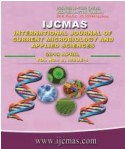


 National Academy of Agricultural Sciences (NAAS)
National Academy of Agricultural Sciences (NAAS)

|
PRINT ISSN : 2319-7692
Online ISSN : 2319-7706 Issues : 12 per year Publisher : Excellent Publishers Email : editorijcmas@gmail.com / submit@ijcmas.com Editor-in-chief: Dr.M.Prakash Index Copernicus ICV 2018: 95.39 NAAS RATING 2020: 5.38 |
A field experiment was carried out in the CR Farm of Gayeshpur, BCKV, Nadia, West Bengal, India during rabi season of 2015-16 and 2016-17 to find out suitable hybrid variety and optimum spacing for different hybrids. Three hybrid varieties of mustard viz. Kesari 5111(V1), Kesari 5222(V2) and Kesari Gold(V3) were taken as treatments in the main plot, whereas, four spacing - 30cm × 10cm (S1), 30cm × 20cm (S2), 40cm × 20cm (S3) and 40cm × 30cm (S4) were imposed as subplot treatment. The experiment was conducted in split plot design with 3 replications and repeated in rabi seasons for two consecutive years (2015-16 and 2016-17). The results of the experiment revealed that the maximum seed yield was recorded in Kesari Gold (1746 and 2153 kg ha-1 respectively in 1st and 2nd year) followed by Kesari 5111. Regarding plant geometry significantly higher yield was noticed in 30 cm × 20 cm (1689 kgha-1 and 2244 kg ha-1respectively in 1st and 2nd year). Crop geometry 40 cm × 30 cm observed superior with respect of number of primary branches/plant and seeds/siliqua, but it was not reflected on seed yield due to less number of plants per unit area. The hybrid varieties of mustard are highly suitable in Gangetic plains of West Bengal due to their higher yields. Slightly wider spacing (30 cm × 20 cm) is suitable for hybrids because of their bigger canopy.
 |
 |
 |
 |
 |